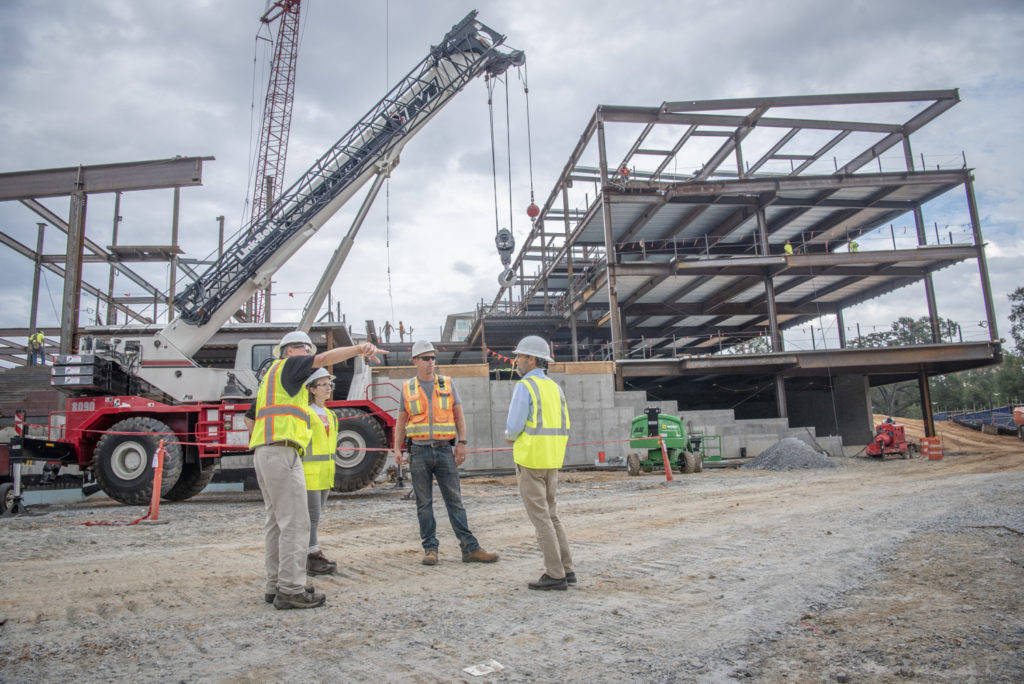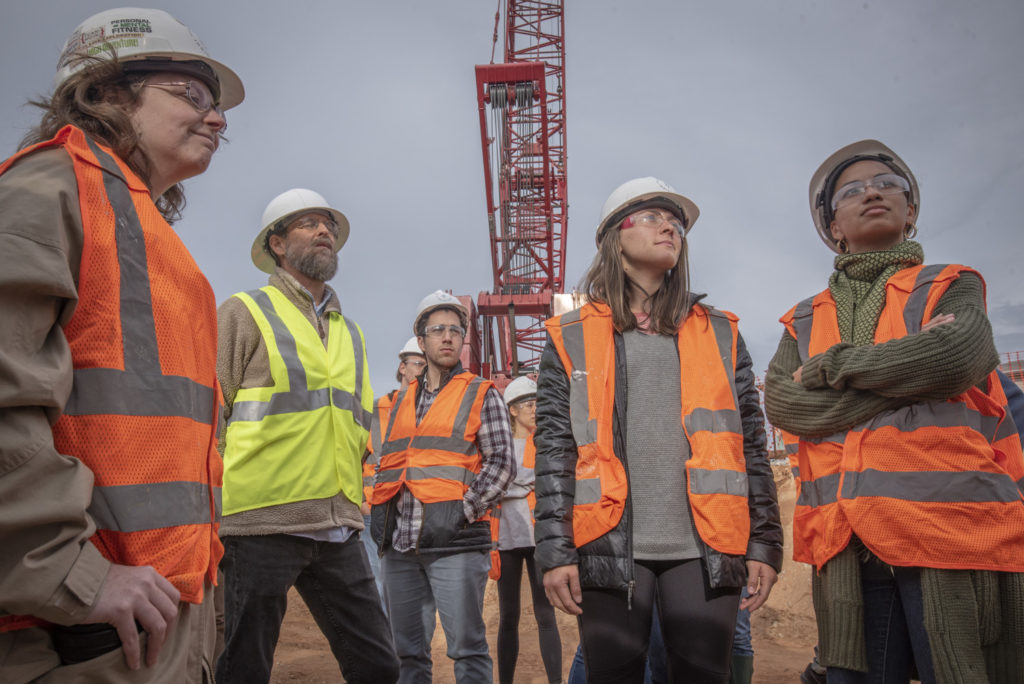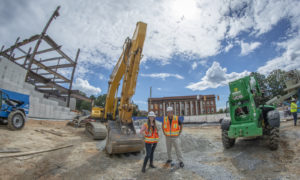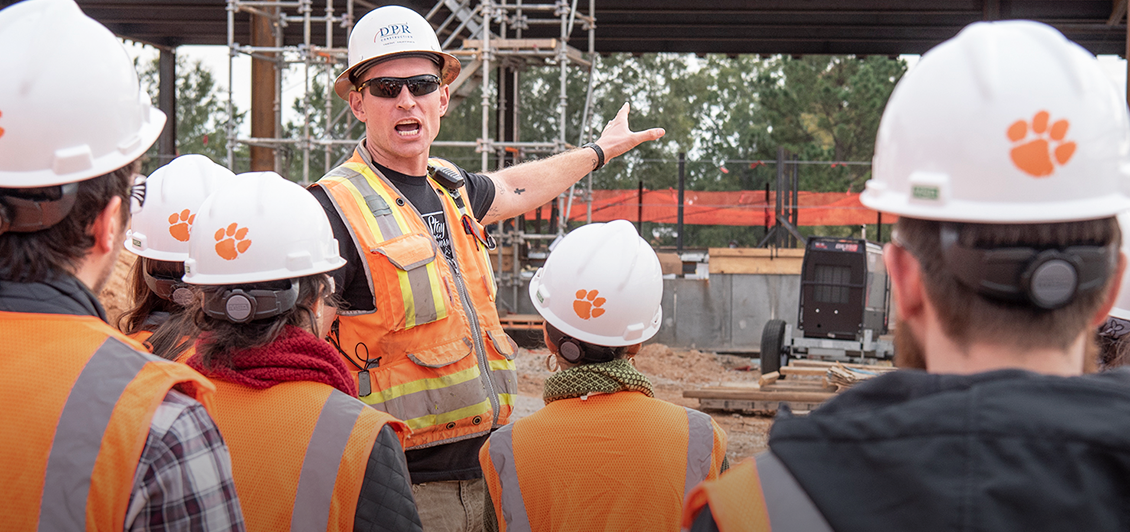Clemson University is in the midst of the largest campus development initiative in its history, implementing a facilities plan designed to help place it in the public eye among the best institutions of learning in America.
Students have not simply been spectators in the process, but rather active participants in every stage.
Faculty — particularly those in construction science and management, civil engineering and the School of Architecture — have capitalized on the construction boom by working campus projects into their curriculums, turning job sites into classrooms.

Teaming up with the University’s Facilities department and the general contractors of major projects like the new College of Business facility, professors have been able to offer students real-world, hands-on experiences with the construction process that could never be replicated in a traditional classroom.
And they start from the very beginning before a single scoop of dirt has been overturned.
“Physically seeing the different pieces of equipment and materials and putting a name to them is a lot different than learning about it from a textbook. Seeing it all to scale is so important,” said Cassidy Bland, a first-year graduate student in architecture + health from Wellsburg, West Virginia. “It is such a valuable experience to see how it actually happens.”
Bland has had the opportunity to take site tours of two of Clemson’s newest construction projects — the new College of Business and the Hoke Sloan Tennis facility down the street — during fall 2018.
Her experience is exactly what Clemson Facilities, the general contractors and faculty are aiming for as they continue to incorporate students into campus building projects.
“We have a perfect learning lab here. This is a great opportunity for students to see footings, concrete foundation walls, structural steel framing and the most modern equipment and construction methodologies in action — some students sat in on our early design meetings,” said Paul Borick, senior project manager for Clemson Facilities, who organizes site tours and facilitates building-related learning opportunities for students and professors. “We’re always trying to share whatever information we have, whether it’s master planning, building design, construction work, even examples of request for proposals, request for quotes and bid documents. Our students get to be flies on the wall during the whole building development process.”
Construction of the nearly 180,000 square-foot College of Business facility is a prime example of these learning opportunities.
A new home for business

Nestled into the hillside across from Bowman Field, the new home for business education at Clemson is quickly rising from the ground. When finished, it will nearly double the space available in historic Sirrine Hall, the college’s current home.
The facility will feature two towers, North and South, connected on the ground and first floors by an expansive outdoor stairway and plaza, and by an interior hallway on the building’s ground floor. The majority of the North Tower will comprise classrooms and labs, while the four-story South Tower will primarily house faculty and staff offices and workspaces.
Wendy York, dean of the College of Business, says the new building is a sign of the commitment University leadership has made to the future of business education at Clemson.
“This world-class learning facility will become a magnet for drawing quality students in pursuit of a business degree that will open doors for them,” York said. “And its location, in the heart of campus, will tell all who pass by that Clemson means business.”
And she loves knowing that Clemson students are fully engaged in unique and interdisciplinary learning opportunities from her college’s expansion.
“Experiential learning is a hallmark of being educated at Clemson,” York said. “Students’ involvement in this magnificent project exposes them to many different disciplines combined in a real-world application. It’s a perfect example of our classroom-without-walls approach to preparing students for the job market.”
From student to intern to professional

For the College of Business project, Dennis Bausman, endowed chair and professor for the University’s construction science and management department, teamed up with executives from DPR Construction, Sherman Construction and Clemson Facilities to create a one-of-a-kind experience for his students. During their final year, Bausman puts seniors through a procurement exercise using the request for qualifications (RFQ) and request for proposal (RFP) from the actual campus building project.
“It is known as Capstone, and it’s a course students take the last semester they’re here. The focus of the course requires students to take all the information they’ve learned in their earlier courses and apply it to a real-world situation. I take the actual RFQ/RFP for the project and the first thing the students have to do is respond to it,” Bausman said. “They develop a written response and they present it to a selection committee composed of project representatives from the architect, contractor and Clemson.”
As the construction manager of record, DPR is charged with balancing the project’s scope, schedule and budget, and coordinating the subcontractor trades so they don’t get in each other’s way. DPR is teamed up with Greenville contractor Sherman Construction on this project. DPR and Sherman also built Clemson’s new 142,500-square-foot Football Operations Center, which opened last year.
The company took on dozens of Clemson students as interns during each of those projects and has subsequently hired many of them after graduation.
“That’s a good illustration of how marketable a degree in construction science and management is,” Bausman said. “Projects like this keep students engaged.”
Allowing the construction site to be used as a learning lab is a win-win, said Justin Tetor ’11 MBA, a DPR Construction project manager on the College of Business facility.
“Sometimes it seems like everybody in our office is a Clemson grad,” he said. “I’m always amazed that you can go to school to learn this stuff. When I was doing internships as an undergraduate at the University of Virginia, there was nothing like this. We have a fantastic internship program, and the Clemson students that come through are amazing.”

Erin Carpenter ’17 was one of those interns. DPR Construction immersed her in the football facility project during her senior year. The experience allowed her to take three years of academic knowledge, gathered in the classroom, and apply it on a working construction site.
“It was indescribable,” she said. “There’s something about being able to go on site, waking up at 2 a.m. to be there for a 3 a.m. concrete pour… it’s so exciting because it’s something you’ve heard talked about for so many years, but you don’t really know what it actually means until you can see it and learn the intricacies and best practices. You learn a lot about yourself and where you want to fit in. You can only be as good as the knowledge you have.”
DPR hired Carpenter as soon as she received her construction science management degree. She’s now based in Germany where she works as a project engineer for the construction of a huge data center.
“It’s easy to get the students engaged in these learning labs, and you couldn’t have a better owner to get engaged with than Clemson,” Bausman said. “Clemson’s project managers are absolutely dynamite. They truly have bought into this. I can’t count how many hours our facilities personnel have given to our kids. It’s been a blessing, and ultimately the ones who benefit are the students.”

